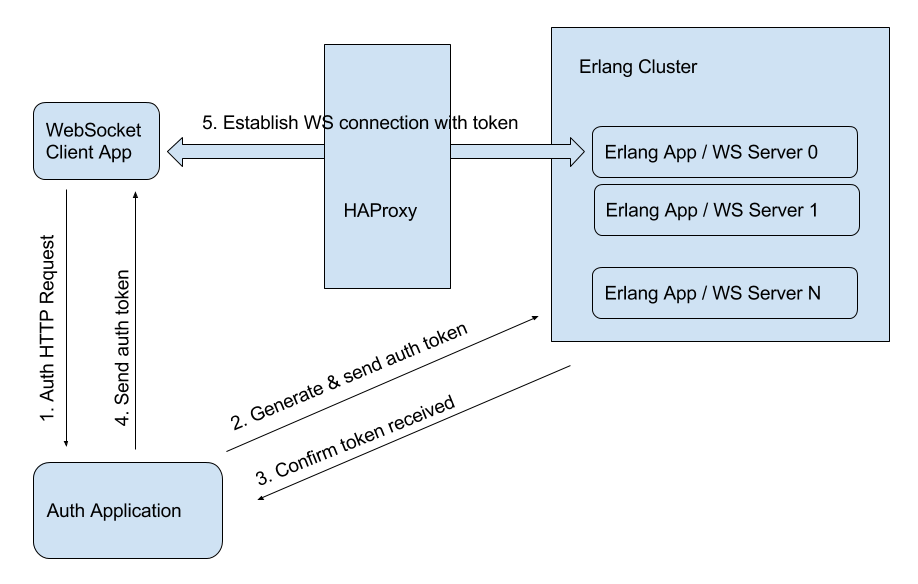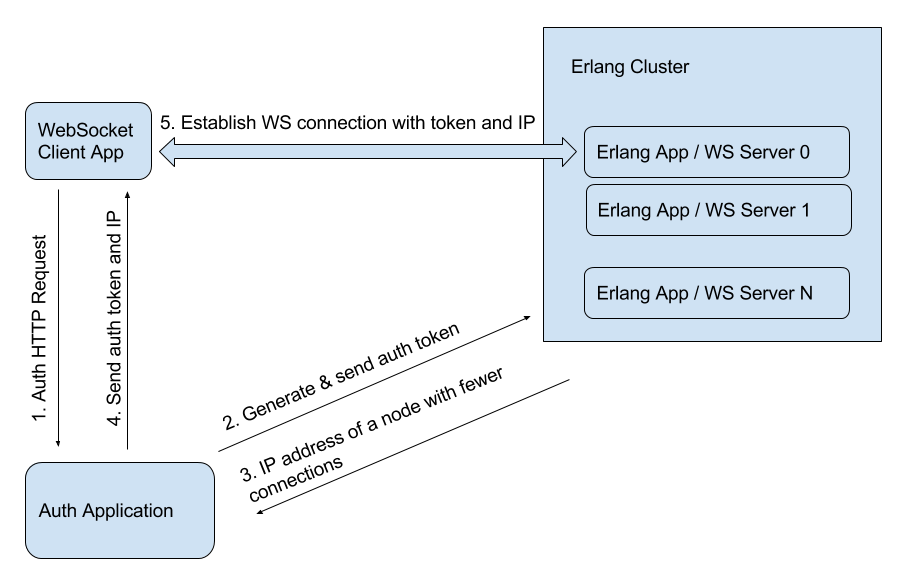The problem of load balancing has always been a hot issue when managing large systems. Load balancing aims to optimize resource use, maximize throughput, minimize response time, and avoid overload of any single resource, so solving this problem is crucial for performance. In this article we’ll take a look at the possible solutions to the problem.
For better understanding of WS load balancing let’s dive a bit deeper into TCP sockets background. By default, a single server can handle 65,536 socket connections just because it’s the max number of TCP ports available. So as WS connections have a TCP nature and each WS client takes one port we can definitely say that number of websocket connections is also limited.
Actually it’s a half-truth. The server can handle 65,536 sockets per single IP address. So the quantity can be easily extended by adding additional network interfaces to a server. Meanwhile, it’s extremely important to track how many connections present on a server.
Once the limit is exceeded, you can have a lot of issues with other TCP connections (e.g. it’s not possible to connect to a server via ssh). So it’s a good idea to limit WS connections per node inside your application’s code. We do the same in our apps when we deal with websockets.
Once we get the major limitation and the way to overcome it, let’s proceed to load balancing. Below I will describe 3 ways we’ve tried in one of our projects. Please note that all the system parts were deployed to AWS and some of tips and hints only apply to Amazon configuration.
ELB Approach
The easiest way to implement load balancing is just to use Elastic Load Balancer AWS provides. It’s possible to switch ELB to TCP mode which enables load balancing of any type of TCP connections including websockets. This approach gives:
- Automatic failover of LB;
- Autoscaling of load balanced nodes;
- Extremely easy setup.
Basically it’s a good solution for most common cases until you have a splash growth of load. In this case ELB becomes too slow to establish new connections . It’s possible to contact Amazon and ask them to “pre-warm” ELB but it was not an option for us due to load-testing purposes when we need quick establishment of thousands of WS connections and for our customer due to usability of the system.
Software Load Balancers
We have tried HAProxy as a load balancer. But to make HAProxy works correctly one should keep in mind the port limitation issue we’ve talked about above. To make HAProxy handle more than 65k connections we should pass through the next steps:
1. Create bunch of private IP addresses. To do it choose your Amazon Instance -> Actions -> Networking -> Manage Private IP Addresses. I.e. there were added 3 IP addresses: 192.168.1.1, 192.168.1.2, 192.168.1.3. Just remember that the IP should be in the same sub-network asyour real application server;
2. Connect to your HAProxy instance via SSH and run following commands:
$> ifconfig eth0:1 192.168.1.1
$> ifconfig eth0:2 192.168.1.2
$> ifconfig eth0:3 192.168.1.3
This will add 3 virtual network interfaces to the instance;
3. Configure HAProxy. Here is a section from haproxy.cfg file for 3 Erlang nodes accepting WS connections.
listen erlang_front :8888
mode http
balance roundrobin
timeout connect 1s
timeout queue 5s
timeout server 3600s
option httpclose
option forwardfor
server erlang-1 192.168.0.1:8888 source 192.168.1.1
server erlang-2 192.168.0.2:8888 source 192.168.1.2
server erlang-3 192.168.0.3:8888 source 192.168.1.3
Now HAProxy can handle more than 65,536 websocket connections and the limit of connections can be easily increased by adding virtual network interfaces. Also, it can establish new connections rather fast.
This approach seemed to be viable despite of following drawbacks:
- Failover HAProxy instance should be set up manually using tools like
keepalived; - Something has to be done to reconfigure HAProxy on whenever you add a new Erlang node;
- As the number of connections grows,there is no option to scale HAProxy horizontally. We have only vertical option available so when we have more and more active users we should obtain more and more expensive instance for HAProxy (and HAProxy mirroring node).
We were fine with these drawbacks but much more simple solution was implemented. That was possible because we had already some code implemented and our system design allowed us to use a custom approach.
Custom Approach
To move forward let’s review the following diagram showing our system architecture.

We have a JavaScript client application, an auth application which is responsible for user authorization and an Erlang application with main application functionality. And the flow is as follows:
- Client makes HTTP request with credentials to Auth Application;
- Auth Application checks creds, generates token and sends it via HTTP request to Erlang Cluster;
- Erlang app confirms that token received and sends HTTP response with confirmations to Auth app;
- Auth App sends HTTP response to client application. This response includes generated token;
- Client uses the token to establish websocket connection with Erlang app through our HAProxy load balancer.
This is our basic flow which was modified slightly. We added a simple module to our Erlang application to track the number of websocket connections on each Erlang node. Due to “distributed” nature of Erlang, each node knows about other nodes connections.
So we can choose a node with fewer connections. We take public IP address of this node and just send back to auth application. Then auth applications sends this IP along with token back to the client. Client establish WS connections with the IP address and token received. So final diagram looks like this:

Now we can:
- Get rid of WS load balancer, which makes our system less complicated;
- Add Erlang nodes without any reconfiguration of other parts of the system.
In addition:
- WS connections are now distributed evenly between the Erlang nodes;
- The system easily scales horizontally;
- We don’t have to use Elastic IPs for Erlang nodes.
Continue reading about Handling Websocket Connections in Erlang Application in our previous post.
Konstantin Shamko
Senior Software Engineer at Oxagile
























